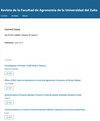Evaluation of fungicides used in the management of black Sigatoka in banana cultivation
IF 0.5
4区 农林科学
Q4 AGRONOMY
Revista De La Facultad De Agronomia De La Universidad Del Zulia
Pub Date : 2023-05-23
DOI:10.47280/revfacagron(luz).v40.n2.06
引用次数: 0
Abstract
The main phytosanitary problem of commercial bananas is black Sigatoka (BS; Mycosphaerella fijiensis), which causes damage to leaf area, loss of exportable quality, and low yields. The management of BS with mixtures of four systemic fungicides in different combinations in the border and central area of three banana plantations, and its effect on the severity of this disease were evaluated. The study was carried out in Ecuador, province of El Oro, Pasaje canton, at the ‘‘El Playón’’, ‘‘Mega Impulso’’ and ‘‘Lolita’’ farms; in an area of 5 hectares of the Williams cultivar with 10 years of production, 50 plants were selected in the vegetative phase in the borders and center of the plantation, four treatments were evaluated: T1 (Triazole+Amine), T2 (Pyrimethanil+Spiroxamine), T3 (Difenoconazole+Amine) and T4 (Amine+Pyrimethanil) and three replicates, with four applications every 14 days. Severity was assessed for 10 weeks using the Stover scale. The experimental design was a randomized block design and the data were analyzed by two-way ANOVA. The greatest fungicidal effect was achieved in ‘‘El Playón’’, the severity for leaf 4 in the border area was 37.5 % and 38 % in the center. On leaf 5, ‘‘El Playón’’ 55 %, ‘‘Mega Impulso’’ 60 %, and ‘‘Lolita’’ 72.5 % reached a severe value. The highest average number of functional leaves was obtained in ‘‘Mega Impulso’’ and the highest average number of old leaves free of streaks in ‘‘Lolita’’. The fungicides applied controlled BS, due to the low percentages of disease severity.杀菌剂在香蕉黑叶斑病防治中的应用评价
商品香蕉的主要植物检疫问题是黑叶斑病(BS;斐济分枝杆菌(Mycosphaerella fijiensis),造成叶面积损害,出口质量下降,产量低。评价了4种系统杀菌剂以不同组合在3个香蕉种植园的边界和中心地区对BS的管理效果,以及对BS严重程度的影响。这项研究是在厄瓜多尔的El Oro省、Pasaje州的“El Playón”、“Mega impulse”和“Lolita”农场进行的;以生产10年的威氏品种5公顷为研究对象,在人工林边缘和中心的营养生长期选择50株,采用T1(三唑+胺)、T2(嘧虫胺+螺虫胺)、T3(二苯唑+胺)和T4(胺+嘧虫胺)4个处理,3个重复,每14 d施用4次。使用Stover量表评估10周的严重程度。试验设计为随机区组设计,数据采用双因素方差分析。以“El Playón”的杀真菌效果最好,4叶在边区和中部的杀菌率分别为37.5%和38%。在第5叶,“El Playón”55%,“Mega impulse”60%,“Lolita”72.5%达到严重值。“Mega impulse”的平均功能叶数最高,“Lolita”的平均无条老叶数最高。由于疾病严重程度的百分比低,使用的杀菌剂控制了BS。
本文章由计算机程序翻译,如有差异,请以英文原文为准。
求助全文
约1分钟内获得全文
求助全文
来源期刊
CiteScore
0.50
自引率
0.00%
发文量
45
审稿时长
>12 weeks
期刊介绍:
La Revista de la Facultad de Agronomía de la Universidad del Zulia publica artículos científicos, notas técnicas, comunicaciones rápidas y artículos invitados originales e inéditos, es decir, que no hayan sido publicados ni enviados simultáneamente a otra revista para su publicación, de autores interesados en el campo agrícola vegetal y agrícola animal. De presentarse el caso que el autor o autores hubiesen enviado o publicado su manuscrito simultáneamente en otra revista, podrán ser sancionados con la no publicación en esta revista por tiempo indefinido.
Se admiten manuscritos escritos en idioma Español, Portugués o Inglés, con un resumen en Español o Portugués y otro en Inglés (Abstract).

 求助内容:
求助内容: 应助结果提醒方式:
应助结果提醒方式:


